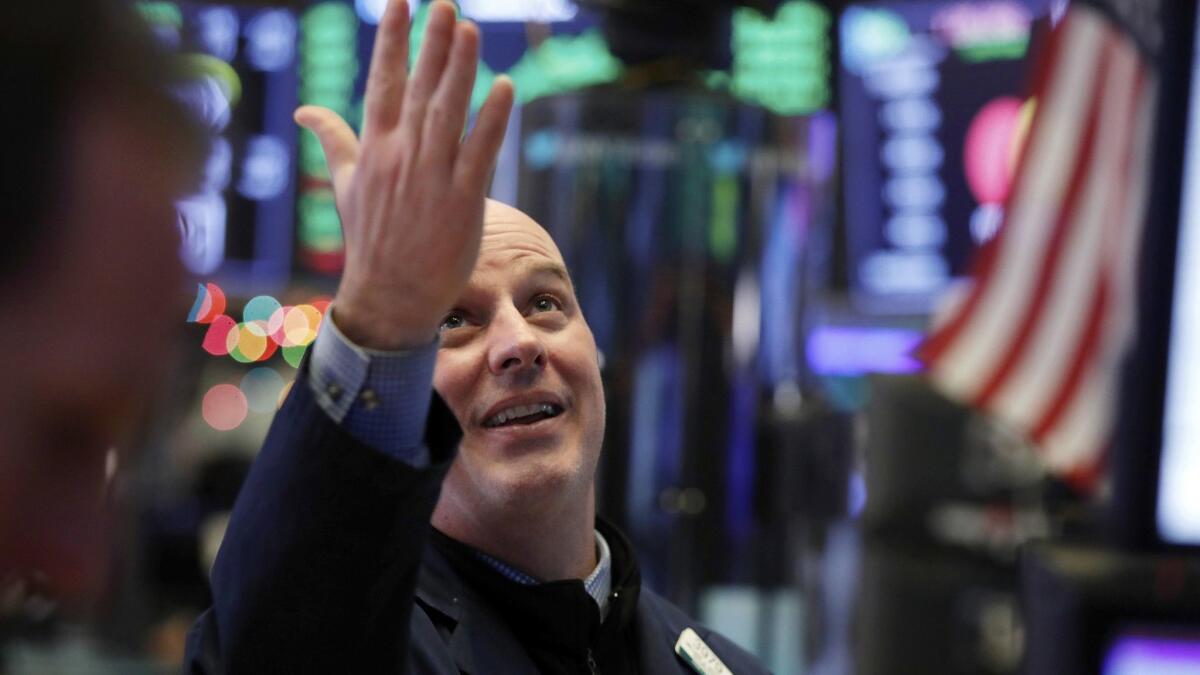Jingle all the way: Dow Jones industrial average jumps 1,086 points

- Share via
U.S. stocks staged one of the biggest rallies of the 9½-year bull market after coming within points of seeing it end. Major indexes surged about 5% or more. The price of crude oil jumped almost 10%.
All but one member of the Standard & Poor’s 500 index finished higher, the Dow Jones industrial average jumped 1,086.25 points for its biggest-ever point gain, and the technology-heavy Nasdaq composite rallied 5.8%.
It was the market’s biggest surge since March 2009.
Consumer shares paced the rally, with Amazon jumping 9.4% after reporting record holiday sales. Each member of the FAANG cohort — tech giants Facebook, Apple, Amazon, Netflix and Google parent company Alphabet — rallied at least 6.4%, while energy producers surged as crude oil leaped past $46 a barrel.
All 30 Dow members gained, with Nike and Apple rising more than 7%. Newmont Mining was the only S&P 500 member to fall.
Good holiday retail sales figures “probably has a lot to do with what’s happening today,” said Kim Forrest, a senior portfolio manager at Fort Pitt Capital Group.
President Trump said a day earlier that the rout that took the benchmark S&P 500 index down 19.8% from its record provided a “tremendous opportunity to buy.” Investors also welcomed Wednesday comments by Kevin Hassett — chairman of the White House Council of Economic Advisors — that Federal Reserve chief Jerome Powell’s job is “100%” safe. Oil’s best rally since 2016 boosted stocks’ surge.
Even with the surge, the stock market is still on track for its worst December since 1931, during the depths of the Depression, and could finish 2018 with its steepest losses in a decade.
But Wednesday’s reminder that consumers — a key part of the American economy — remain on solid footing helped soothe anxiety created by fears of a global economic slowdown and White House personnel churn. A late report that a U.S. government delegation will travel to China in two weeks to hold trade talks gave stocks a final push higher.
Forrest also noted stocks’ recent big swings. “You have the market leaning one way or the other, and it can often do what it’s doing today, which is go higher. On Monday the market leaned lower. It’s an outsize move.”
The S&P 500 ended Monday just 7 points away from a bear market — a psychologically important 20% drop from a recent peak.
So was Wednesday’s rally a resurrection of the bull market or just a dying gasp?
Strong rallies are common in troubled times. In eight previous bear markets, the S&P 500 has experienced rallies of greater than 2.5% more than 120 times as the benchmark index plunged from peak to trough. From the collapse of Lehman Bros. to the financial crisis bottom in March 2009, the S&P 500 rallied more than 4% on 13 occasions.
“Bear markets always serve up some very nasty rallies,” said Doug Ramsey, chief investment officer of Leuthold Weeden Capital Management, which manages about $1.2 billion. “There’s a saying that bear market rallies look better than the real thing.”
But the resurrection scenario has played out before, too.
In 2011, the S&P 500 dropped 19.4% from April 29 to Oct. 3. At that bottom, the index experienced three days of gains greater than 1.5% — and continued on to its best month in 20 years. That recovery paved the way for the longest bull market ever recorded, the one that was salvaged Wednesday.
Something similar happened in 1998, when the index suffered a drop of more than 19%, bottoming on Oct. 8, before a 2.6% rally spared it from oblivion. From October’s start to the end of January the following year, the index surged nearly 25%.
Still, for many traders watching their screens explode in green, massive gains are viewed with suspicion.
“This is not the kind of price action you see in normal bull markets,” said Michael Antonelli, equity sales trader at Robert W. Baird. “This is just a face-ripping short cover rally. I am 100% not saying we are in a situation like 2008 now, but look at Oct. 10, 2008, to Oct. 13, 2008: The market rose nearly 12% in one day. Oct. 27 to Oct. 28, 2008, it rose 11%.”
To call the bottom, Antonelli is looking for, along with other indicators, at least two consecutive days in which more than 90% of the index’s stocks rise — an event that happened today. Until then, suspicion will run high.
“I view it with skepticism until it’s proven with a few metrics: volume, breadth, sentiment,” he said. “But right now I just view it skeptically because this isn’t normal price action.”
All told Wednesday, the S&P 500 climbed 116.60 points, or 5%, to 2,467.70. The Dow climbed 1,086.25 points, or 5%, to 22,878.45. The Nasdaq soared 361.44 points, or 5.8%, to 6,554.36. The Russell 2000 index of smaller-company stocks climbed 62.89 points, or 5%, to 1,329.81.
In commodities trading, benchmark U.S. crude jumped 8.7% to $46.22 a barrel. Brent crude, used to price international oils, climbed 7.9% to $54.47 a barrel. The pickup in oil prices helped boost energy stocks.
Bond prices fell. The yield on the 10-year Treasury note rose to 2.79% from 2.75%.
The only stock in the S&P 500 to fall was Newmont Mining, which slipped 0.1%. The gold and copper producer’s stock fell as the price of gold gave up some of the ground it had gained earlier in the day, pulled down by a strengthening dollar and rising stock market.
The Associated Press was used in compiling this report.
More to Read
Inside the business of entertainment
The Wide Shot brings you news, analysis and insights on everything from streaming wars to production — and what it all means for the future.
You may occasionally receive promotional content from the Los Angeles Times.






